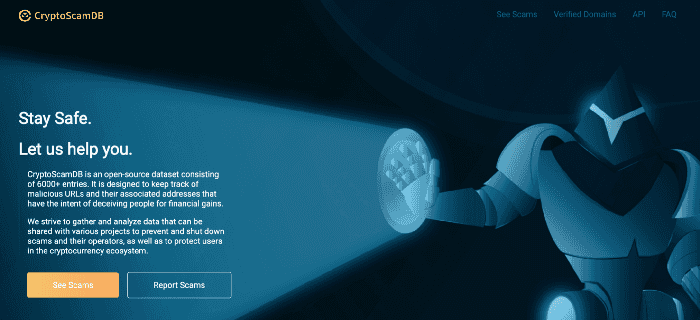As the cryptocurrency ecosystem gets larger, we need a place to index any and all cryptocurrency-related scams and phishing campaigns — not just those that target Ethereum users.
Today, we are excited to launch CryptoScamDB.org.

The CryptoScamDB is a database that currently houses records of 6500+ known scams across Ethereum, Bitcoin, XRP, NEO, and many more chains.
Start using CryptoScamDB now to:
- Check to see if an address/URL is verified or not
- Report a malicious address/URL
- Arm yourself with knowledge
Originally known as EtherscamDB
On July 31, 2017, the first version of EtherScamDB was born. It was designed to replace a Google Sheets document created by Taylor Monahan to track Ethereum phishing and scamming links. At the time, the database consisted of roughly 2000 malicious entries.
On December 24, 2017, we released EtherScamDB 2.0.0, which replaced static page generation with dynamic page generation using Express. By this time, our database consisted of over 2600 malicious entries.
Finally, on July 19, 2018, we started working on EtherScamDB 3.0.0. Due to a growing demand for tracking scams outside of the Ethereum ecosystem, this version never got released, and instead got rebranded as CryptoScamDB.
The project aimed to be an open directory of scam and phishing campaigns targeting users in the Ethereum ecosystem. The directory would hold details of domains and addresses, connecting them with other campaigns. Pretty much every day since, the directory has been updated with new campaigns that have been submitted by the community and verified to be malicious.
EtherScamDB has been helpful in other projects and educating people on different types of scams and how to recognize them. Some examples of great uses of our data are:
- A comprehensive analysis of the most lucrative scams, compiled by Brandon Arvanaghi and John Backus.
- Warning messages posted in the comment section of block explorers (mainly Etherscan) and forums (e.g., bitcointalk.org) with links to our index to warn other users.
- The consumption of our data by PhishFort to incorporate into their browser extension.
This project aims to be a single source to lookup flagged domains and addresses for multiple chains, offering screenshots and other details of the offending site. The data will be viewable with a fresh new UI as well as a freely-accessible API (though do credit the project if you consume our data).

Our method of submitting the data is still open and audit-able — we are still pushing to our databases with git commits; all the data is open to best help protect the community from the bad guys.
We encourage the use of our data to help better protect the cryptocurrency community through the use of our documented API.